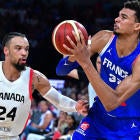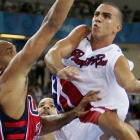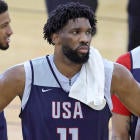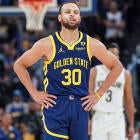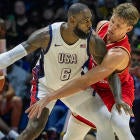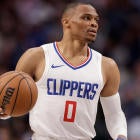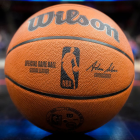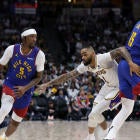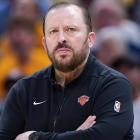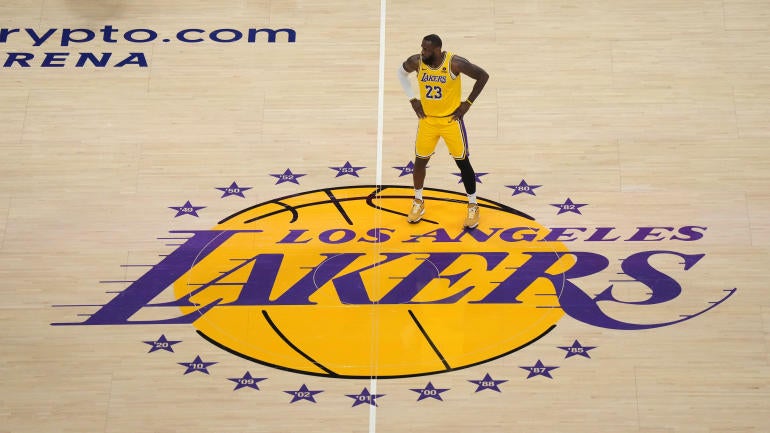
One year ago, on January 23, 2023, the Los Angeles Lakers were an underperforming team with 22 wins. Today, the Lakers are an underperforming team with 22 wins. But last year's team didn't fold. Rob Pelinka overhauled the roster. LeBron James and Anthony Davis led a group of newcomers in Rui Hachimura, D'Angelo Russell and Jarred Vanderbilt to within eight wins of the championship.
That run is probably informing the way the Lakers are looking at the 2024 trade deadline. The Lakers have been linked to just about every big name on the market. Their 2029 first-round pick—at the moment, their only tradable one—is seemingly up for grabs. So are pick swaps, second-rounders, role players, potentially almost anything the Lakers can muster to recreate last spring. Perhaps credibly, perhaps not, the Lakers seem to believe that merely having James and Davis, healthy and performing as superstars, gives them a chance.
It's a risky proposition to bet your future on for a number of reasons. The simplest is that last year's team had a lot more promise than this year's. James missed 10 of the first 44 Laker games last season. Davis missed 19. They've combined to miss only six games so far this season, yet last year's group had a better net rating at this point in the season (-0.6 vs. -0.9). There's no Russell Westbrook around this time to soak up blame. The Lakers either signed, re-signed or drafted every player on this season's roster within the past 19 months except for James and Davis. This is the group they chose, and it's not working.
In fairness, the Lakers have set an impossibly high standard in that regard. They literally broke up a championship team in the winter of 2020. James joined the team in 2018. This is at least the fifth iteration of the Lakers' roster he's been a part of. There's an argument to be made that the Lakers need to let this group play through the bumps to develop the continuity it's never had. Rob Pelinka seemed interested in that approach over the summer.
Of course, while he stood still, the rest of the conference got better. Denver led the Western Conference with a .646 winning percentage last season. Four Western Conference teams are beating that mark so far this year, to say nothing of the sleeping giant Suns who have now won six straight since getting healthy. The Lakers couldn't handle one championship-caliber team last postseason. They might need to beat three to reach the Finals this time around. You could argue the entire top five out West has three All-Star-caliber players. The Lakers might not have a third player capable of starting for the Timberwolves, Thunder or Nuggets.
So what's the approach with a bit more than two weeks left before the trade deadline? Are the Lakers worth trying to save? Or is this team a lost cause? Should they go fishing for a few minnows, or a whale? Let's take a look at the four feasible game-plans the Lakers could employ leading up to the Feb. 8 trade deadline. Who might their targets be? What would they cost? And what would the overarching plan look like?
Path 1: Big-game hunting
Despite the frequency with which they've made win-now trades over the past several years, the Lakers really haven't sacrificed that much of their future yet. They owe one unprotected pick to the Pelicans that could convey as soon as June or as late as 2025. With James and Davis in their current state, neither of those picks figure to haunt the Lakers too much. After that, the last pick they owe is in 2027, and it's top-four protected. Otherwise, the Lakers control their drafts. For the time being, the option to rebuild naturally whenever they choose still very much exists for the Lakers. Trade any more unprotected picks or swaps and that option fades away.
What is that optionality worth? A fair bit, honestly. It's not 2018 anymore. The last All-NBA player to move through free agency was DeMar DeRozan in 2020. Eventually the Lakers are going to need to replace or supplement James and Davis as the faces of their franchise, and to do that, they'll either need picks to draft with or picks to trade with. That doesn't necessarily mean that trading meaningful draft capital now needs to bring back a star. It just means that sacrificing the chance to get one later sets a pretty high bar for whatever player does come back. More options might emerge later on, but for now, the Lakers appear to be eyeing two players in this price range: Dejounte Murray and Bruce Brown.
Both provide similar theoretical strengths, but with an emphasis on "theoretical." Brown is a strong defender who can guard above his size, but most defensive metrics rate him below his reputation. Murray's reputation is only now catching up with his actual play. He was an elite defensive point guard in San Antonio, but has slipped tremendously in Atlanta. Could he return to form? There's no reason to think he couldn't. He's still only 27. Point-of-attack defense has been a problem for the Lakers since they let Alex Caruso slip away. A trade like this works only if Brown or Murray help the Lakers improve meaningfully in that regard.
They'd both bring needed offensive traits as well. Murray's playmaking and mid-range game would fit in nicely on an offense that just needs shots created however possible. Brown can bring a bit of ball-handling too, but slides a bit more comfortably into the old connector role Caruso vacated. He's an excellent cutter and screener that makes good decisions in tight quarters. The question for both is 3-point shooting. Brown is fairly good from the corners at roughly 38% for his career, but bad everywhere else.
Murray is having a career shooting season. The sample isn't remotely big enough to prove genuine improvement beyond acceptability. His shot diet is much harder than Brown's. Ironically, it's the tightly guarded shots Murray is thriving on this season (41.4% on 77 attempts) and the wide-open ones where he's struggling (30.4% on 46 attempts). I have no easy explanation for that. Murray was better on the wide-open looks last season, but he's never been great on them. Those are the shots you'd hope he gets playing next to James.
Would either thrive in that setting? Murray has played far better when he hasn't had to share the ball with Trae Young in Atlanta. Could he coexist in a timeshare with James, and likely Austin Reaves? Brown's best basketball has come on teams with endless spacing and heavy motion offenses. This isn't Denver. He won't get rewarded for cutting in the same way he did playing with Nikola Jokic. Brown's value decreases significantly if he's playing stationary offense. Shooting is this team's biggest need. Is it worth sacrificing your best trade chips for players that may not fix it? Especially when the matching salary in such a deal—D'Angelo Russell—is among your best shooters?
It's hard to say. Murray is the higher upside play, something closer to the "third star" the Lakers have spent years looking for. Brown is closer to the role players they won the 2020 title with, but that team was far-better equipped to absorb a high-end role player. You could argue that the Lakers need both. They're only getting one, though Atlanta's interest in Reaves opens some doors to bigger deals (Bogdan Bogdanovic would go a long way toward solving the shooting problems).
Are the Lakers prepared to bet that the majority of their current roster would make more sense with one high-end addition? Would players like Rui Hachimura and Taurean Prince get better looks with one player above them in the pecking order on both sides? The theoretical hope here is that a player like Murray or Brown could snap the rest of the roster into place, making their lives easier and allowing them to play the smaller roles they're better-suited for. But again, this is all theoretical. Neither Murray nor Brown is a slam dunk. How much certainty will the Lakers need to trade away their future? Only Pelinka knows the answer.
Path 2: Fixing the fringes
The Lakers have looked into cheaper guards. Collin Sexton is playing his way off of the trade market. Tyus Jones seems like a near-certainty to get moved somewhere as an impending free agent who plays for the Wizards. There are teams he's worth a first-round pick to. The Lakers probably aren't one of them. The pure point guard archetype is less of a priority to the Lakers than defense and shooting. If he can be had for second-rounders or some of the lesser prospects here? He's enough of a talent upgrade to add.
The Raptors have multiple viable additions. The Lakers have coveted Gary Trent Jr. in the past. They've employed Dennis Schroder twice. Both appear to be trade candidates as the Raptors embark on a mini-rebuild. If the Lakers want to keep their payroll down, a run at Quentin Grimes, who is still on a rookie-scale deal through next season, might be worthwhile, though he can probably net a first-rounder at this stage. Malcolm Brogdon probably does as well, but he's certainly worth a phone call. The backup center market is bustling. Nick Richards and Daniel Gafford would both be upgrades on the current options. Buddy Hield has never made it through a trade deadline without falling into the rumor mill.
The real avenue to watch on this front, or really any, is the buyout market. The new CBA created an extremely favorable climate for the Lakers here. Any team above the first apron cannot add buyout players whose previous salary was above the non-taxpayer mid-level exception. That knocks the Warriors, Clippers, Suns, Bucks, Celtics, Heat and Nuggets out of the running. The 76ers might be out as well depending on how much salary they add at the deadline. The Lakers won't be the best team on the buyout market, but they might be the most desirable. They can offer theoretical winning and actual minutes in a great market.
Who's going to be available here? It's hard to say, but we're typically looking for players on either bad teams or that could be traded off of good teams that have hefty expiring salaries. The dream target here is Gordon Hayward, though no reporting has yet suggested that he could seek a buyout despite the Hornets' pitiful 10-31 record. Kyle Lowry was just shipped to Charlotte, too, but Gabe Vincent has shown the Lakers the dangers of investing in players the Heat are willing to lose. Evan Fournier has barely played in two years. Maybe he could give the Lakers a bit of cheap shooting if the Knicks use his salary elsewhere.
The goal here would be to fill a few specific roster weaknesses with the hope that doing so might spark a return to form for some of the players that have yet to replicate last season's form. Would doing so lead to genuine championship contention? Probably not. But it's a way to prove to the key stakeholders here that the team is looking to improve. That would be an important element of our next possibility.
Path 3: Wait-and-see
Making a big trade becomes a lot easier for the Lakers this summer. At that point, they'll have three tradable first-rounders—either their 2024 or 2025 pick along with their selections in 2029 and 2031—along with swap rights in three more years. They could put Reaves in a deal for the right package. The same would be true for 2023 first-round pick Jalen Hood-Schifino. With so many players signed to long-term deals last summer, they'd have the matching salary to do whatever they want.
Is that enough to trade for a real, no-questions-asked superstar? It depends on the player and the circumstance. If someone is prepared to force their way to Los Angeles like Davis did, it becomes very possible. In a bidding war situation? Probably not. The Knicks, Nets and Heat all have more to trade than the Lakers do if a player seeking a market upgrade like Donovan Mitchell comes up. If a surprising MVP candidate hits the market, the Lakers can't compete with the Thunder, Jazz or Spurs in terms of sheer asset volume. Their best hope might be for a star with relatively low stock right now to become available in the hopes that they could rehabilitate him. Trae Young springs to mind here. According to ESPN, the Lakers have had internal discussions along these lines.
This would be a risky gambit on several levels that extend beyond even landing the third star. James turns 40 next season. No 40-year-old has ever averaged even 15 points per game. Any version of the Lakers that's contending for real needs James hovering around 25. There's no telling how healthy Davis is in a year. Could the Lakers build a supporting cast around three stars in a second-apron world? Would they even want to?
Part of the appeal of trading for someone like Murray or Brown now is that it could be seen as the first stage of a greater reset that would be completed this summer. Move the 2029 pick now, see how the new player fits and then retrofit around him with the 2031 and 2024/25 picks over the summer. At least in that scenario you're sure you're getting one difference-making player. Wait and you might end up with nothing. End up with nothing and ... well ...
Path 4: The end is near
James can become a free-agent this offseason. The Lakers probably have a better idea of what his plans are than we do, but this summer poses a major risk to the Lakers that might be out of their control. Bronny James will be draft-eligible in June. It's no secret that the elder James wants to play with him. The Lakers may not even have their first-round pick in this upcoming draft. Plenty of appealing teams still have theirs. What if Cleveland drafts Bronny? Or Miami? What if Daryl Morey aims his max cap space at James and offers his son as the cherry on top?
James could stay with the Lakers this summer. Either way, the end of this era of Laker basketball is going to end relatively soon, and if the Lakers are ready to start preparing for it, there are steps they can take in the short term. If winning right now is no longer the main goal, for instance, the Lakers would surely love to dip back below the luxury tax line. They're less than $2 million above it for now, and as this is their fourth-straight taxpaying season, they're primed to pay the repeater penalty. It goes without saying that the Lakers would prefer not to pay it.
What exactly a post-James future might look like in Los Angeles is unclear. Davis signed an extension last offseason. Would he want to stick around on a team that would be presumably less competitive? Would the Lakers prefer to try to find him a running mate, or would they rather kick off a rebuild? How many current Lakers have a place on the post-James team? Definitely Reaves. Probably not too many after him.
This is the least likely plan for a number of reasons. It's not in the Lakers' nature to concede when there are riskier win-now options on the board. But the Lakers are .500 today, and James is set to miss Tuesday's game against the Clippers. After Thursday's home date with the Bulls, they go on a six-game road trip that doesn't end until deadline day. Things don't look great now. They might look worse in two weeks. The Lakers probably aren't going to actively tear down their team in February, but if they sense that this team's window to contend is closing, don't be surprised if they hold their assets and perhaps look to save a bit of money rather than going all-in on one or two more runs.










